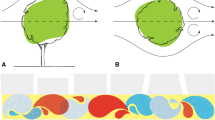Abstract
The Ozone Fine Structure Model (OFIS) model allows an adequate description of urban photochemistry at a very low computational effort. Thus, it may be used for statistical analyses of urban scale ozone levels, including the assessment of control strategies and exposure estimates. Recent model extensions allow taking properly into account emission inhomogeneities in the surroundings of the considered city and local circulation systems. The performance of both the standard and the extended OFIS model versions is illustrated by its application to Stuttgart and Athens. The results reveal that the model extensions allow for more versatility in inhomogeneous situations.
Similar content being viewed by others
References
Deardorff, J.W.: 1974, Three-dimensional numerical study of the height and mean structure of the heated planetary boundary layer, Bound.-Layer Meterol., 7, 81–106.
EEA: 1998, European State of the Environment Report, European Environment Agency, Copenhagen.
Kärenlampi, L. and Skärby, L. (eds.): 1998, Critical levels for Ozone in Europe: Testing and Finalizing the Concepts, UN/ECE Workshop Report, University of Kuopio, Department of Ecology and Environmental Science, Finland.
Kessler, Ch.: 1995, Entwicklung eines effizienten Lösungsverfahrens zur Beschreibung der Ausbreitung und chemischen Umwandlung reaktiver Luftschadstoffe, Verlag Shaker, Aachen, 148 pp.
Moussiopoulos, N., Sahm, P., Tourlou, P.M., Friedrich, R., Wickert, B., Reis, S. and Simpson, D.: 1998, Technical Expertise in the Context of the Commission's Communication on an Ozone Strategy, Final report to European Commission DGXI.
Moussiopoulos, N.: 1990, Influence of power plant emissions and industrial emissions on the leeward ozone levels, Atmos. Environ. 24A, 1451–1460.
Moussiopoulos, N.: 1995, The EUMAC Zooming Model, A tool for local-to-regional air quality studies, Meteorol. Atmos. Phys., 57, 115–133.
Moussiopoulos, N., Berge, E., Bohler, T., Leeuw, F., Gronskei, K-E., Mylona, S. and Tombrou, M.: 1997, Ambient Air Quality, Pollutant Dispersion and Transport Models, European Topic Centre on Air Quality, Topic Report 19, European Environment Agency, EU Publications, Copenhagen, 94 pp., (URL: http://eea.eu.int/frdocu.htm).
Sahm, P.: 1998, Kopplung eines nicht-hydrostatischen prognostischen Grenz-schicht-modells und eines mesoskaligen Ausbreitungsmodells für reaktive Stoffe, Fortschr.-Ber. VDI, Reihe 15, Nr. 199, 170 pp.
Sahm, P., Kirchner, F. and Moussiopoulos, N.: 1997, Development and Validation of the Multilayer Model MUSE-The Impact of the Chemical Reaction Mechanism on Air Quality Predictions, Proceedings of the 22nd NATO/CCMS International Technical Meeting on Air Pollution Modelling and its Application, Clermont-Ferrand, France, June 2-6, 1997.
Simpson, D.: 1993, Photochemical model calculations over Europe for two extended summer periods: 1985 and 1989, Atmos. Environ., 27A, 921–943.
Simpson, D.: 1995, Biogenic emissions in Europe 2: Implications for ozone control strategies, J. Geophys. Res., 100 D11, 22891–22906.
Author information
Authors and Affiliations
Rights and permissions
About this article
Cite this article
Sahm, P., Moussiopoulos, N. & Janssen, J. The Ozone Fine Structure Model: Model Concept and Options. Environ Monit Assess 65, 305–312 (2000). https://doi.org/10.1023/A:1006444221068
Issue Date:
DOI: https://doi.org/10.1023/A:1006444221068




